The ozone hole over Antartica develops each year between:
(a) Late august-early october
(b) March-April
(c) October-november
(d) January -february
late august-early october
march-April
October-november
January -february
The correct Answer is:A
To solve the question regarding when the ozone hole over Antarctica develops each year, we can follow these steps:
1. Understand the Question: The question asks about the specific time period during which the ozone hole over Antarctica develops each year.
2. Recall the Characteristics of the Ozone Layer: The ozone layer is a protective layer in the Earth's atmosphere that absorbs most of the sun's harmful ultraviolet radiation.
3. Identify the Ozone Hole Formation: The ozone hole is a significant depletion of ozone in the stratosphere, primarily caused by human-made chemicals like chlorofluorocarbons (CFCs).
4. Consider the Seasonal Patterns: The formation of the ozone hole is linked to the seasonal changes in Antarctica, particularly during the spring.
5. Evaluate the Options:
- Option (a): Late August - early October
- Option (b): March - April
- Option (c): October - November
- Option (d): January - February
6. Determine the Correct Time Frame: The ozone hole typically begins to form in late winter (August) and reaches its maximum size in early spring (October). Therefore, the correct answer is option (a) Late August - early October.
7. Conclude the Answer: The ozone hole over Antarctica develops each year between late August and early October.
Final Answer:
(a) Late August - early October
---
- Option (a): Late August - early October
- Option (b): March - April
- Option (c): October - November
- Option (d): January - February
(a) Late August - early October
Topper's Solved these Questions
- ENVIRONMENTAL ISSUESBOOK - DINESH PUBLICATION ENGLISHCHAPTER - ENVIRONMENTAL ISSUESEXERCISE - Check your grasp
18 Videos
- ENVIRONMENTAL ISSUESBOOK - DINESH PUBLICATION ENGLISHCHAPTER - ENVIRONMENTAL ISSUESEXERCISE - Brain teasers-X
145 Videos
- ECHINODERMATABOOK - DINESH PUBLICATION ENGLISHCHAPTER - ECHINODERMATAEXERCISE - REVISION QUESTIONS
65 Videos
- EVIDENCES OF EVOLUTIONBOOK - DINESH PUBLICATION ENGLISHCHAPTER - EVIDENCES OF EVOLUTIONEXERCISE - CHECK YOUR GRASP
19 Videos
Similar Questions
A month is selected at random in a year. The probability that it is March or October, is 112 (b) 16 (c) 34 (d) None of these
View SolutionA, B C and D are large conduting plates kept parallel each other,A and D are fixed. Plates B and C connected to each other by a rigied conduction rod, can slide over friction less rails as shown,Initially the distence between T1 ates C and D.If now the rod (along with plates B and C) is slightly moved toward right, the capacitance between the terminals 1 and 2
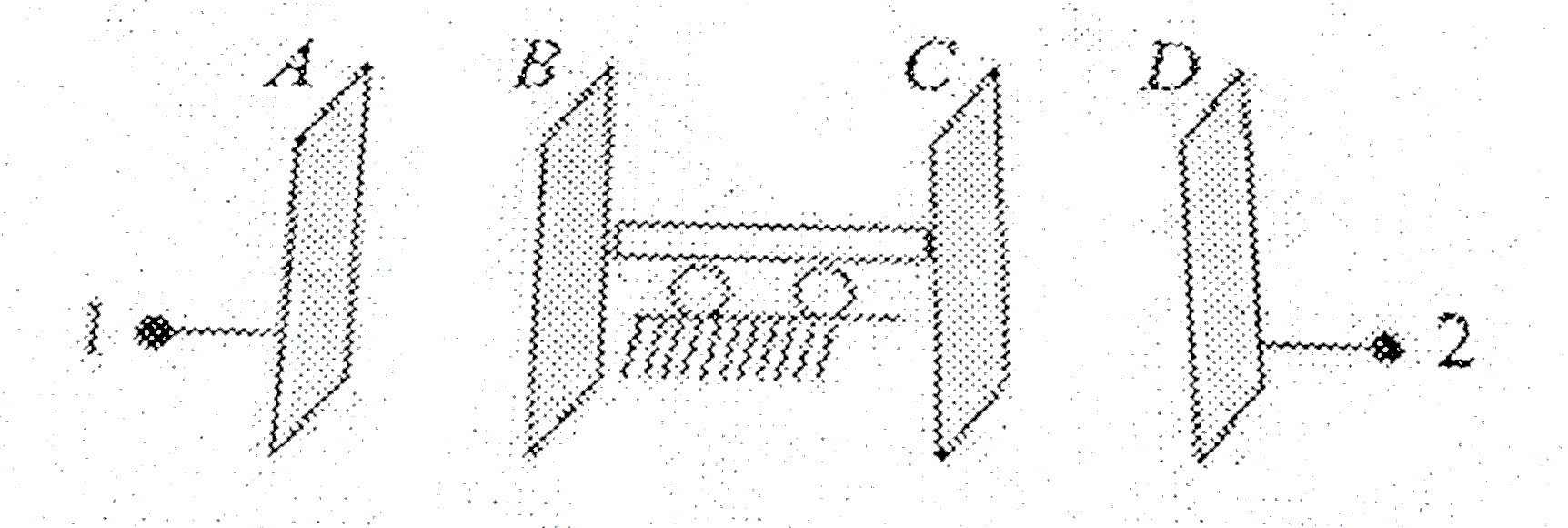
View SolutionThe figure given below represents the female reproductive system of a mammal. Parts indicated by the guidelines A to D are as follows:
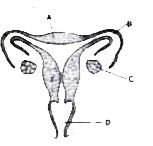
(A) Uterus
(B) Fallopian tube (oviduct)
(C) Ovary
(D) Vagina
(a) Give appropriate terms for each of the following:
(i) The onset of reproductive phase in a young female.
(ii) Rupture of follicle and release of ovum from the ovary
(iii) Monthly discharge of blood and disintegrated tissues in human female.
(iv) Process of fusion of ovum and sperm.
(v) Fixing of developing zygote on the uterine wall.
(vi) The permanent stoppage of menstruation at about the age of 45 years in a female.
(b) State the functions of the (0) Placenta (ii) Amniotic fluid. [ICSE 2004, 2015]
(c) Using the symbol "X' indicates the region in the diagram where fertilisation occurs.[ICSE 2004)
View SolutionAnswer question numbers 3(a) - 3(d) on the basis of your understanding of the following paragraph and the related studied concepts:
Around the year 1800, only 30 elements were known. Dobereiner in 1817 and Newlands in 1866 tried to arrange the then known elements and framed laws which were rejected by the scientists. Even after the ejection of the proposed laws, many scientists continued to search for a pattern that correlated the properties of elements with their atomic masses.
The main credit for classifying elements goes to Mendeleev for his most important contribution to the early development of a Periodic table of elements wherein he arranged the elements on the basis of their fundamental property, the atomic mass and also on the similarity of chemical properties. The formula of their hydrides and oxides were treated as basic criteria for the classification of the elements.
However, Mendeleev's classification also had some limitations as it could not assign the position to isotopes. He also left some gaps in the periodic table.
3(a) state Mendeleev's Periodic Law.
3(b) Why did Mendeleev leave some gaps in the Periodic table?
3(c) if the letter 'R' was used to represent any of the elements in the group , then the hydride and oxide of carbon would respectively be represented as
(i) RH4, RO
(ii) RH4, RO2
(iii) RH2, RO2
(iv) RH2, RO
3(d) isotopes are
(i) atoms of an element with similar chemical properties but different atomic masses.
(ii) atoms of different elements with similar chemical properties but different atomic masses.
(iii) atoms of an element with different chemical properties but same atomic masses.
(iv) atoms of different elements with different chemical properties but same atomic masses.
View SolutionThe following bar graph shows the number of persons killed in industrial accidents in a country for some years (Figure) Read the bar graph and choose the correct alternative in each of the following: The year which shows the maximum percentage increase in the number of persons killed in coal mines over the preceding year is:
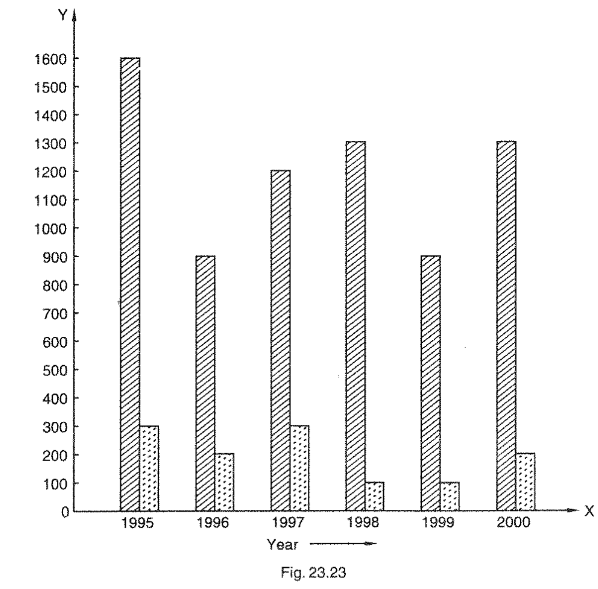
View SolutionGiven below are four statements A to D, select the option in which two statements are correct?
A: In earthworms deelopment is indirect and the larva is trochophore larva.
B: A mutual exchange of sperms occurs between two worms during mating.
C: Fertilisation is internal occurs within the cocoon deposited in soil
D: About 3 weeks are required for development, each cocoon produces two to twenty baby worms with an average of four.
View SolutionConsider a block of conducting material of resistivity 'ρ' shown in the figure. Current 'I' enters at 'A' and leaves from 'D'. We apply superposition principle to find voltage ΔV developed between 'B' and 'C'. The calculation is done in the following steps:
(i) Take current 'I' entering from 'A' and assume it to spread over a hemispherical surface in the block.
(ii) Calculate field E(r) at distance 'r' from A by using Ohm's law E=ρj, where j is the current per unit area at 'r'.
(iii) From the 'r' dependence of E(r), obtain the potential V(r) at r.
(iv) Repeat (i), (ii) and (iii) for current 'I' leaving 'D' and superpose results for 'A' and 'D'.
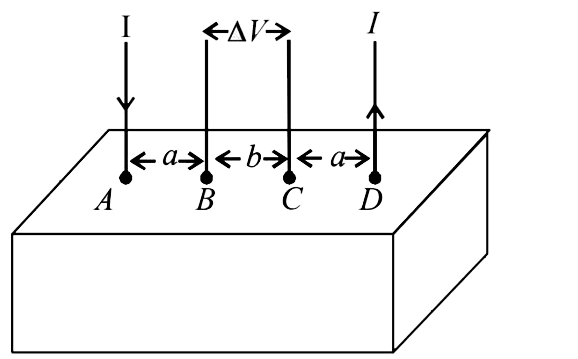
Delta V measured between B and C is
View SolutionPassage-II:
Consider a block conducting material of resistivity .ρ. shown in the figure. Current .I. enters at .A. and leaves from .D.. We apply superposition principle to find voltage .ΔV. developed between .B. and .C.. The calculation is done in the following steps :
i) Take current .I. entering from .A. and assume it to spread over a hemispherical surface in the block.
ii) Calculate field E(r ) at distance .r. from A by using Ohm.s law E=ρj, where j is the current per unit area at .r..
iii) From the .r. dependence of E(r ), obtain the potential V(r ) at r.
iv) Repeat (i), (ii), (iii) for current .I. leaving .D. and superpose results for .A. and .D..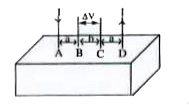
For current entering at A the electric field at a distance .r. from A is
View SolutionA cyclotron is device for accelerating ions and charged particles. It was developed by Lawerence in 1932.
The heart of the appritus consists of a split metal pillbox. Figure sHOws top and front views of the halves called dees. A rapidly oscilating potential difference is applied between the Dees. This produces an oscilating electric field in the gap between the dees, the region inside each dee being essentially free of electric field. The Dees are enclosed in an evaccutaed container, and the entire unit is placed in a uniform magnetic field B whose direction is normal to the plane Of Dees, A charged particle of mass 'm' and charge 'q' in the gap between the dees, it moves with constant speed in a semi-circle.
The period of uniform circular motion is T=2πmqB and is independant of speed. If the time-period of the oscilating elctric field is equal to this time, then the charged particle will be accelerated again and again

Answer the following questions (consider the mass of particles remains constant during motion):
A cyclotron has been adjusted to accelereted deutrons. It is now to be adjusted to accelerate other particles , for this following changes may be made:
(a) In order to keep the frequency of oscillating electric field same, the magnetic field is halved for proton
(b) If the magnetic field remain unchanged, the oscillation frequency of electric field should be halved for α particle
(c ) If the magnetic field remain unchanged, the oscillation frequency of electric field should be double for proton
(d) If the frequency of oscillating electric field is kept same, the magnetic field should be kept same for α particle
View SolutionThere block A B ,and C of equal mass m are placed one over the other on a frictionless surface (table) as shown in figure The coefficient of friction between any blocks A ,B and C is μ The maximum value of mass of block D so that the blocks A,B and C move without slipping over each other is
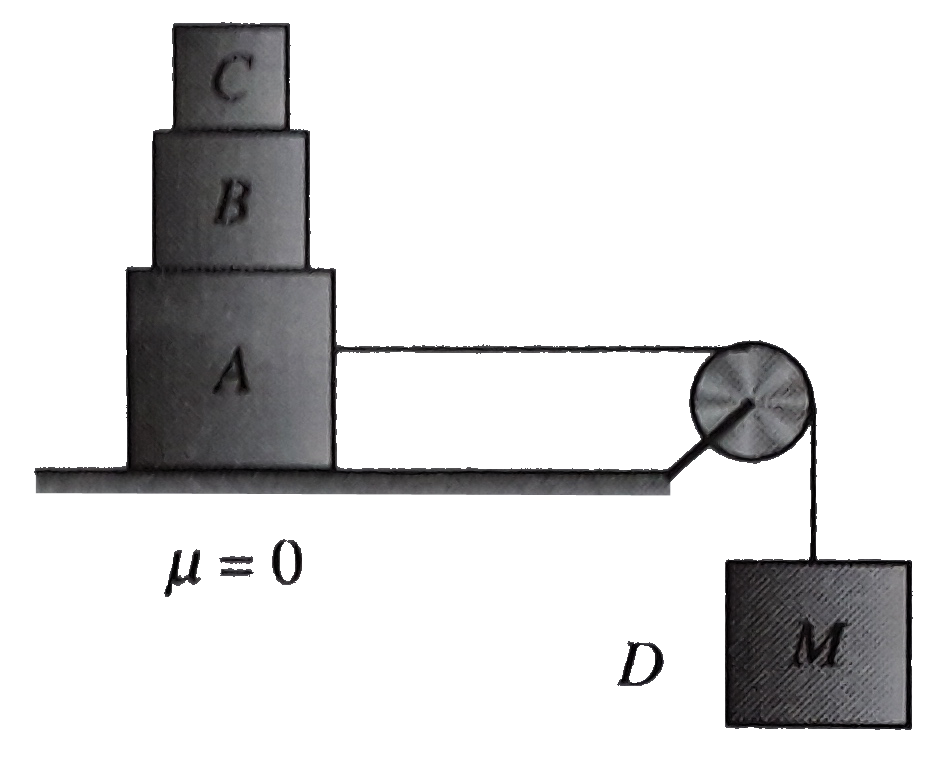
View Solution
